Besides being the oldest chicken breed in America, Dominique chickens have a lot more to offer.
From exceptional egg and meat production to great companionship, all at a low maintenance cost, you can never go wrong with a Dominique chicken flock.
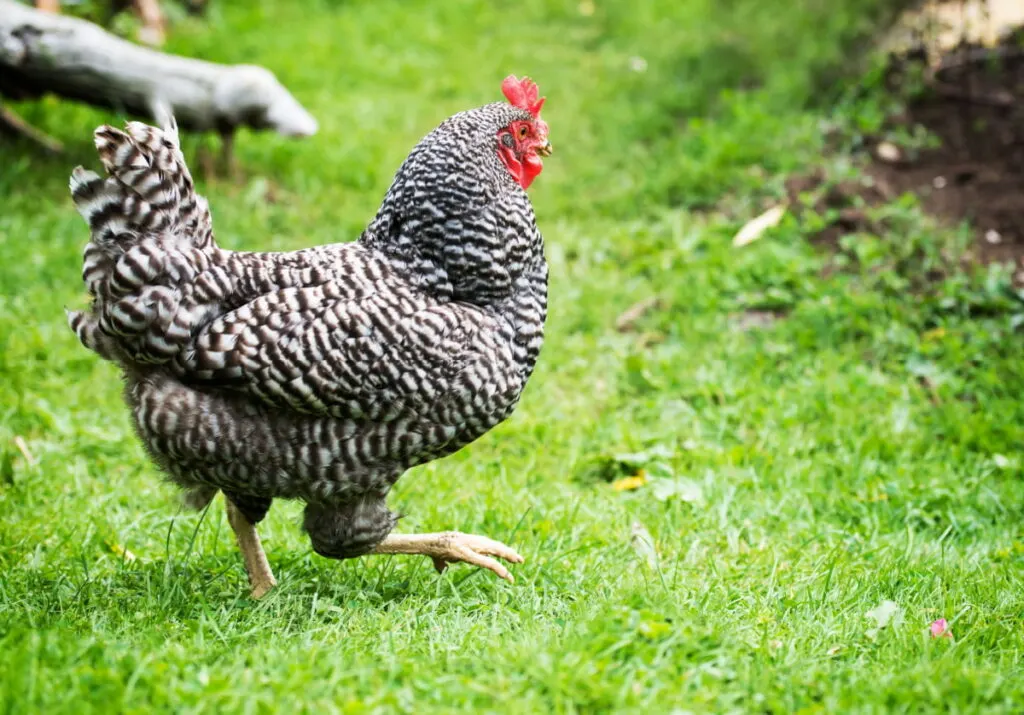
Table of Contents
History
Dominique chickens are America’s oldest chicken breed, with some of the earliest poultry books attributing to it as a revered American breed.
The breed’s popularity began in the 1750s, after which the breed was widely distributed across the eastern United States. It is still a popular dual-use chicken breed, but where did it come from?
Well, the exact origin of the Dominique chicken breed is unknown, but it is believed to derive from birds similar to the modern-day Sussex or Dorking chicken breeds.
These supposed birds were introduced to America by Southern England colonists.
Ever since its initial emergence, the breed has gone by numerous names, including:
- Dominic
- Pilgrim fowl
- Dominoico
- Blue Spotted hen
- Old Grey hen
- Dominicker
All these names are derived from the various theories about the breed’s origin and history.
It is, however, commonly referred to as Dominique and was among the chicken breeds shown in Boston at America’s first poultry show in 1849.
Two decades later, in1869, the Plymouth Rock — a cross between single-combed Pilgrim fowl and Black Java — hit the show rings after its development. Plymouth Rocks are quite similar to Dominiques except for their larger size and coloration.
A year later in 1870, only rose-combed Dominiques were exhibited in the New York poultry show.
Single-combed birds previously referred to as Dominiques were from then on shown as Plymouth Rocks.
In 1871, the rose comb ruling was reinforced in the Dominique breed’s Standard of Excellence.
Later, in 1874, the Dominique chicken breed was added to the first edition of the American Poultry Association’s Standard of Perfection.
Its hardiness and thrifty nature made Dominique the breed of choice for many small farm owners.
The breed’s numbers, however, started declining after the breed survived the First World War and the Great Depression.
The second threat to the breed’s numbers came when it was deemed unproductive for the commercial market after the industry became mechanized.
As a result, only four breeding flocks remained by the 1970s.
Luckily, the breed’s numbers increased after The American Livestock Breed Conservancy encouraged flock owners to participate in their breeding program.
Thankfully, the breed’s status now stands at ‘watch.’ Lastly, the Dominique’s bantam variety was added to the Standard of Perfection in 1960.
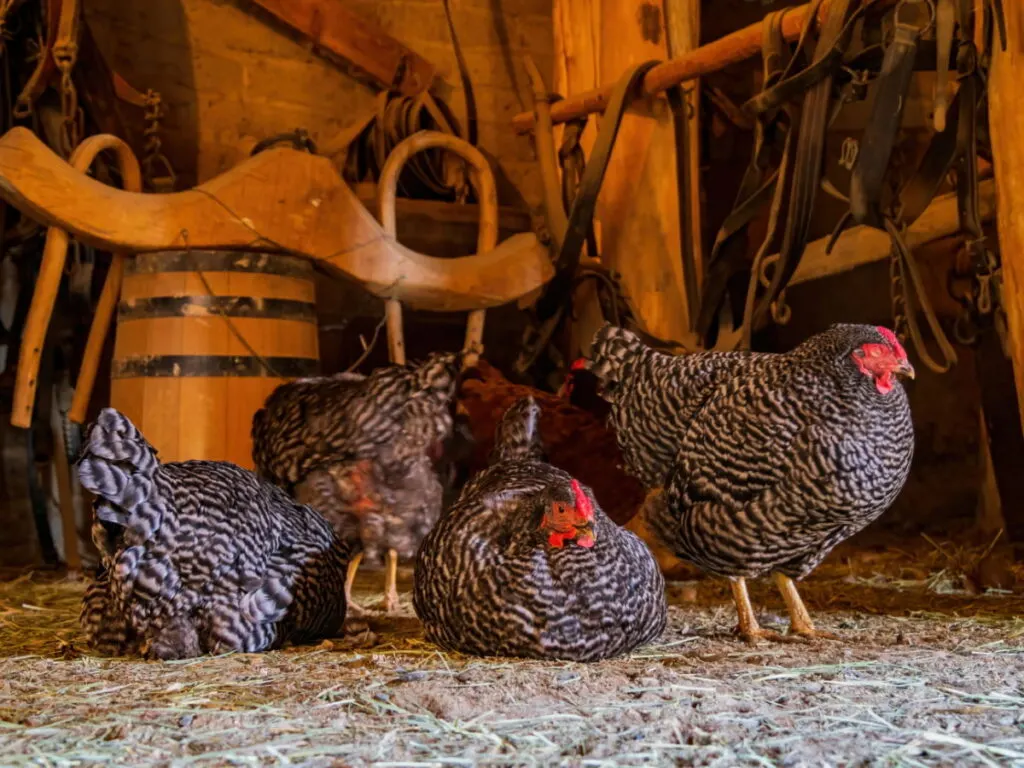
Appearance
Dominique chickens are an American Poultry Association-recognized breed and are categorized as medium-sized.
At first glance, Dominique chickens share a striking resemblance to the Plymouth Rock. However, upon a closer look, various things differentiate the two chicken breeds.
While the two breeds share the renowned barred or black-and-white pattern, their combs are an easy way to tell them apart.
Combs on Plymouth Rocks are usually upright while Dominiques have rose combs that are pretty much flat with a single spike pointing backward.
Though seemingly the same, the pattern of both chicken breeds is another way to tell them apart. This, however, requires you to pay close attention.
Dominiques’ plumage patterns are jagged, with little contrast between the black and white shades.
This coloration is also referred to as hawk coloration, and it offers the perfect camouflage from predators.
Plymouth Rocks, on the other hand, have a sharp barred pattern, hence the true contrast between the black and white colors.
What’s more, Dominiques carry their heads high, with the yellow bills contrasting perfectly with the red wattles and earlobes. The breed also has clean and yellow legs and feet.
Thanks to a rose comb and the tightly packed plumage, Dominique chickens are more resistant to frostbite than other chicken breeds.
Size
Being a medium-sized breed, roosters average a weight of 7 pounds while the hens weigh in at 5 pounds.
Their bantam counterparts average 28 ounces for the roosters and 24 ounces for the hens.
Uses
Like most chicken breeds, Dominique chickens are also raised for their dual-purpose nature — that is, for their eggs and meat.
Besides keeping the birds warm in cold weather, the tight feathers on Dominiques are also used for feather beds and pillows, mostly by bird owners.

Egg Production
Dominiques are commendable egg layers — they are considered to be among the best-laying chicken breeds.
Dominique hens lay at least 4 eggs per week. This gives you an average of 230 to 275 brown, medium-sized eggs yearly — ideally weighing 2 ounces each.
That being said, you can expect the size of the eggs to increase gradually as the hens grow bigger and older.
Meat Production
At 5 to 7 pounds, Dominique chickens make a profitable commercial option when available in bulk.
Otherwise, these chickens are a great source of meat for subsistence use.
Luckily, they are yellow-skinned birds and, therefore, effortlessly edible.
Varieties and Color
Dominique chickens are only recognized in cuckoo coloration, which is more of a light and dark color pattern as opposed to a barred pattern of white and black coloring.
There are currently no recognized or registered varieties of Dominique chickens in the United States.
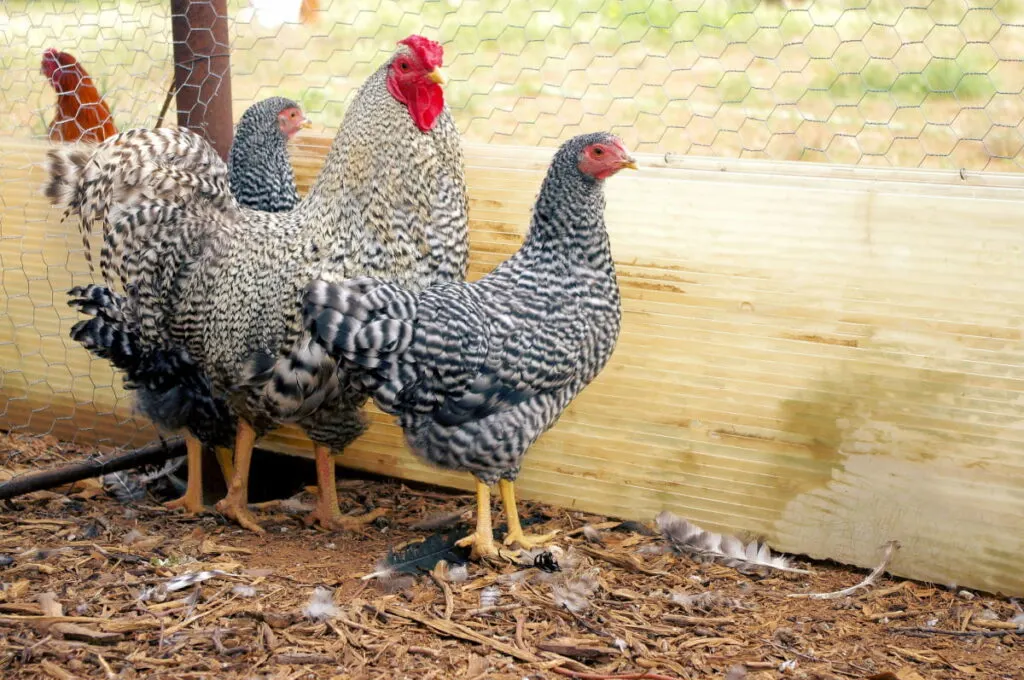
Temperament
Besides being the oldest chicken breed in America, Dominiques are also famous for their friendly and calm demeanor. This makes them ideal for raising as pets and for your backyard flock.
While their calm nature means that they coexist with each other and other backyard breeds, Dominique roosters may turn aggressive, especially during the breeding season, and may fight hens and other roosters when threatened.
The hens are, however, calm and friendly with their keepers. Similarly, the chicks are quite friendly and fun and will often gather at your feet for treats and some love.
Broodiness
Dominique hens occasionally get broody. Those who get broody become attentive and caring mothers and protect their chicks. As a result, they are exceptional at raising their brood.
Sexing
Luckily, Dominique chicks are auto-sexing, making them easy to distinguish upon hatching.
All Dominique chicks hatch with whitish spots on their heads. However, the spots on female chicks are small and concentrated while those on their male counterparts are scattered.
Another way to tell the chicks apart is by paying attention to their tiny legs. Male chicks have rich yellow legs while female chicks have a burnt orange to brownish hue on their legs.
That being said, head spots are the most accurate way of sexing Dominique chicks.
Noise Levels
Dominiques are relatively quiet when loved and cared for properly. They are especially happy when you allow them to roam and forage naturally.
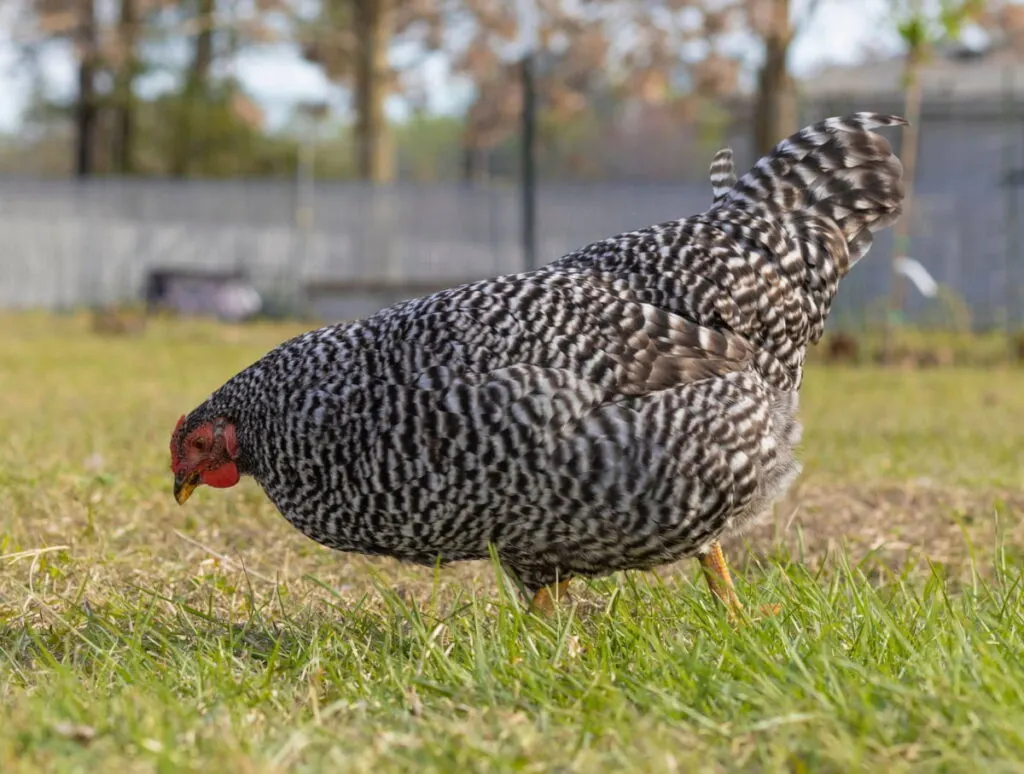
Nutrition
Thanks to their love for foraging, Dominiques are a relatively easy breed to feed.
Unlike other breeds that prefer regular chicken feed, these natural foragers will happily eat what they find over standard chicken feed.
Due to their foraging nature, Dominique chicken diet is mainly made up of bugs, berries, and pretty much other edible things found outdoors.
This is one of the reasons why it is such a cheap and low-maintenance chicken breed to raise.
Also, due to their expert foraging skills, Dominiques are ideal for pest control in your garden.
Though they are quite capable of fending for themselves, you must supplement their diet with standard chicken feed to provide any nutrients they may be lacking.
You can do this through scheduled or free-feeding intervals. Either will work for your birds as it allows them enough time to roam and forage.
Be sure to only go for high-quality chicken feeds.
Lastly, you need to ensure that your flock has unlimited access to fresh and clean drinking water.
All in all, as long as your Dominiques have enough room to roam freely, they will always be fed, satisfied, and happy.
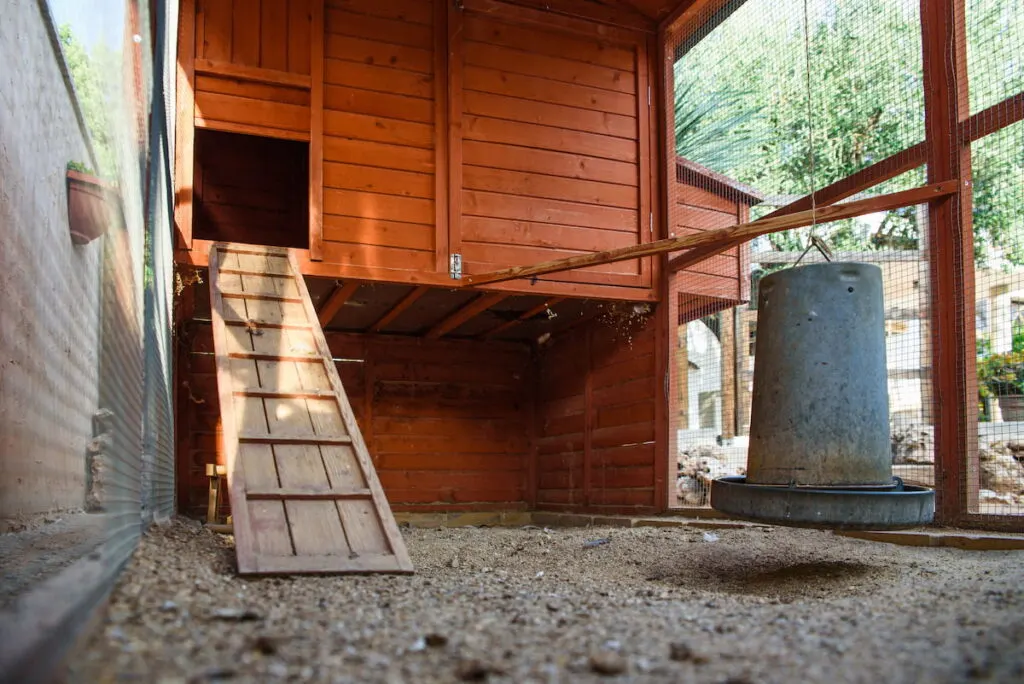
Housing
Regarding coop setup, your birds will be happy with at least three square feet of floor space each. That being said, they will be happier with more floor space where possible.
What’s more, the hens will need at least 12×12 inches of nesting space or box each. Raised wood platforms will offer roosting spots for your flock.
All in all, a regular coop setup will suffice.
Run and Roaming
As Dominiques are excellent foragers, ensuring their run has enough room for each bird to roam freely and forage is crucial.
It is advisable to have at least eight square feet of rooming space within their enclosed run.
If you are short of space and don’t have an enclosed run, ensure you let your birds out to roam throughout the day and keep an eye out for predators.
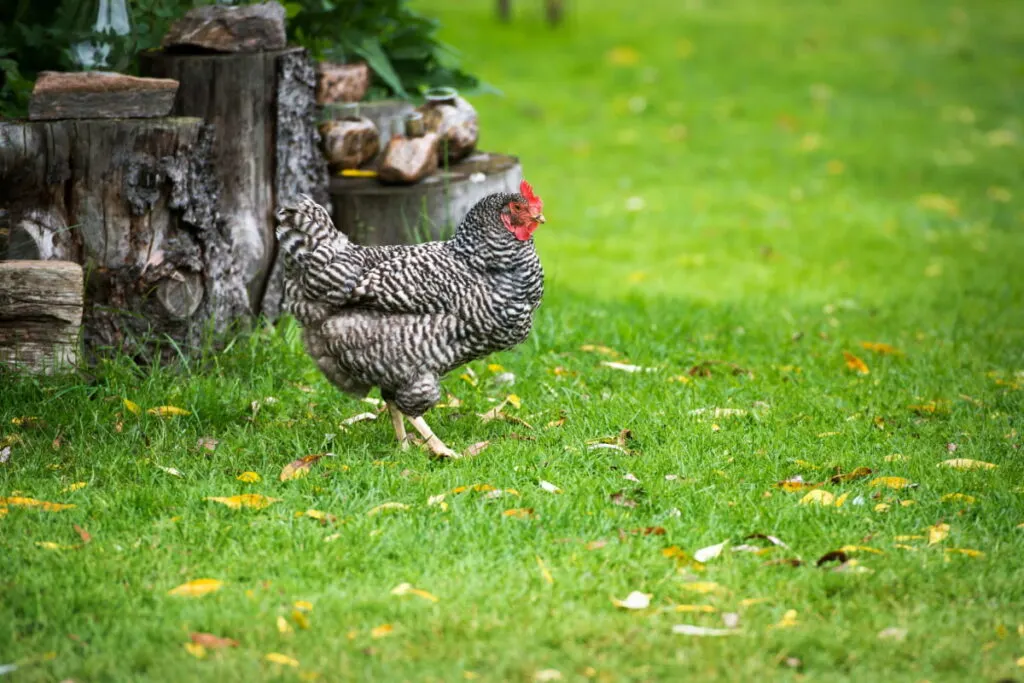
Common Health Issues
Dominique chickens are a fairly hardy and healthy breed without any genetic health issues to look out for. As a result, they are rather easy to care for and keep healthy.
But like other chicken breeds, taking the necessary care to prevent and treat your birds against common pests and parasites is important.
A large part of this entails maintaining a clean and hygienic environment for your birds.
Final Thoughts
There you have it. Nothing beats a hardy chicken breed with commendable egg and meat production and a calm disposition to top it all up.
The Dominique chicken breed offers all these and more, making it ideal for novice and experienced keepers alike. Thankfully, you now know what to expect from the breed.
Resources:
- https://www.communitychickens.com/breed-profile-dominique-zbw1910ztil/
- https://en.wikipedia.org/wiki/Dominique_chicken
- https://www.chickensandmore.com/dominique-chicken/#Noise_Levels
- https://livestockconservancy.org/heritage-breeds/heritage-breeds-list/dominique-chicken/
- https://backyardpoultry.iamcountryside.com/chickens-101/the-delightful-dominique-chicken/
- https://breeds.okstate.edu/poultry/chickens/dominiques-chickens.html
- https://www.roysfarm.com/dominique-chicken/
- https://cs-tf.com/dominique-chicken/
- https://www.thehappychickencoop.com/dominique-chicken/
